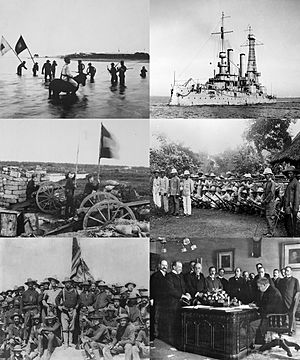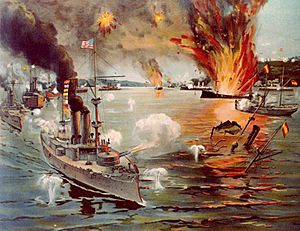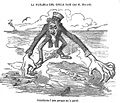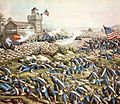Spanish–American War facts for kids
Quick facts for kids Spanish–American War |
|||||||||
|---|---|---|---|---|---|---|---|---|---|
| Part of the Philippine Revolution and the Cuban War of Independence |
|||||||||
|
(clockwise from top left)
|
|||||||||
|
|||||||||
| Belligerents | |||||||||
| Commanders and leaders | |||||||||
|
|||||||||
| Strength | |||||||||
|
|
||||||||
| Casualties and losses | |||||||||
|
American:
|
Spanish:
|
||||||||
| The higher naval losses may be attributed to the disastrous naval defeats inflicted on the Spanish at Manila Bay and Santiago de Cuba. | |||||||||
The Spanish–American War was a short war that happened in 1898. It was fought between Spain and the United States of America. One main reason for the war was that many people wanted Cuba to become independent from Spain. Also, some Americans wanted their country to gain a colonial empire overseas. Spain lost the war, especially at sea. Because of this, Spain had to give up its colonies: Cuba, the Philippines, Puerto Rico, and part of Guam. All of these places, except Cuba, became U.S. territories after the war.
Why the War Started
Before the war, there were many reports of Spain treating Cubans badly. Spain was trying to control Cuba and had put many Cubans into camps. The United States sent warships to Cuba to try and make Spain give up control.
A U.S. battleship called the Maine exploded in Cuban waters. About 260 people on board died. After this, a popular saying became "Remember the Maine!" U.S. newspapers quickly blamed Spain for the explosion. These newspapers used a style called "yellow journalism," which often used exciting or exaggerated stories. This, along with pressure from ordinary people, pushed the U.S. government to go to war. Some people simply wanted Cuba to be free. Others hoped the United States could build its own colonial empire, just like many European countries had done.
How the War Was Fought
Many volunteers across the United States joined the war effort. Theodore Roosevelt, who later became president, formed a group of soldiers called the Rough Riders. He became famous for leading them during the Battle of San Juan Hill in Cuba.
A big naval battle happened in the Philippines. An American fleet, led by George Dewey, completely destroyed the Spanish fleet there. On land, battles took place in Cuba and Puerto Rico.
The United States won the war quickly. They soon began to take control of the former Spanish colonies after Spain surrendered. Around 400 American soldiers died in fighting. However, more than 4,000 Americans died from diseases. These diseases included yellow fever, typhoid, and malaria.
End of the War
The war officially ended when the Treaty of Paris was signed. This happened on December 10, 1898, between the United States and Spain. With this treaty, the United States gained control of Puerto Rico, Guam, and the Philippines.
Images for kids
-
A Spanish satirical drawing published in La Campana de Gràcia (1896) criticizing U.S. behavior regarding Cuba by Manuel Moliné. Upper text reads (in old Catalan): "Uncle Sam's craving", and below: "To keep the island so it won't get lost".
-
Illustrated map published by the Guardia Civil showing the Kingdom of Spain and its remaining colonial possessions in 1895 (Caroline and Mariana Islands, as well as Spanish Sahara, Morocco, Guinea and Guam are not included.)
-
Spanish Marines trenched during the Battle of Manila Bay
-
Spanish artillery regiment during the Philippine Campaign
-
Spanish infantry troops and officers in Manila
-
The Spanish armored cruiser Cristóbal Colón, which was destroyed during the Battle of Santiago on July 3, 1898
-
Detail from Charge of the 24th and 25th Colored Infantry and Rescue of Rough Riders at San Juan Hill, July 2, 1898, depicting the Battle of San Juan Hill
-
Charge of the Rough Riders
-
Oil on canvas painted and signed with initials A.A. by Antonio Antón and Antonio Iboleón, around 1897. It is an ideal view of the Spanish Squadron of Instruction in 1896, before the war of 1898, since the ships represented never sailed together. On the left the Battleship Pelayo with insignia, followed by the cruisers Cristóbal Colón, Infanta María Teresa and Alfonso XIII; on the right, the cruiser Carlos V with insignia, Almirante Oquendo and Vizcaya. On the starboard side of the Pelayo sails the torpedo boat Destructor; Two Furor-class destroyer boats sail along the bows of the Carlos V. Stormy sea and partly cloudy skies.
-
Cámara's squadron in the Suez Canal in July 1898. His flagship, the battleship Pelayo, can be seen in the foreground,. The last ship in the line is the armored cruiser Emperador Carlos V. The squadron never saw combat.
-
Jules Cambon, the French ambassador to the United States, signing the memorandum of ratification on behalf of Spain
See also
 In Spanish: Guerra hispano-estadounidense para niños
In Spanish: Guerra hispano-estadounidense para niños























